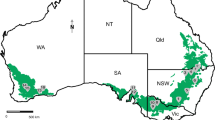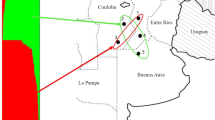Abstract
Crown and root rot of wheat caused by Fusarium pseudograminearum is one of the most important wheat diseases in Iran. In this study, the genetic structure and aggressiveness of four populations of F. pseudograminearum were investigated in five provinces of Iran. Sixty-four isolates of F. pseudograminearum, isolated from samples collected from wheat fields, were examined for genetic diversity and structure, using six simple sequence repeat markers. Fifty-eight haplotypes were identified, indicating that there was a high level of genotype diversity among Iranian isolates of F. pseudograminearum. Most of the variation (90 %) was observed within populations and only 10 % among populations. The greatest genetic similarity was detected between the Qazvin–East Azarbaijan and Lorestan populations, and the greatest genetic distance was between the populations of Lorestan and Golestan. Considerable variations in aggressiveness were observed among 40 isolates of F. pseudograminearum, which had been selected for greenhouse studies. No consistency was observed between the molecular variation and aggressiveness of the isolates. In general, the high genetic diversity accompanied with aggressiveness indicated that both of the aspects should be taken into consideration for resistant breeding program and the development of disease management strategies.



Similar content being viewed by others
References
Akinsanmi OA, Backhouse D, Simpfendorfer S, Chakraborty S (2006) Genetic diversity of Australian Fusarium graminearum and F. pseudograminearum. Plant Pathol 55:494–504
Akinsanmi OA, Backhouse D, Simpfendorfer S, Chakraborty S (2006) Pathogenic variation of Fusarium isolates associated with head blight of wheat in Australasian. J Phytopathol 154:513–521
Akinsanmi OA, Mitter V, Simpfendorfer S, Backhouse D, Chakraborty S (2004) Identity and pathogenicity of Fusarium spp. isolated from wheat fields in Queensland and northern New South Wales. Aust J Agric Res 55:97–107
An ZW, Xie LL, Cheng H, Zhou Y, Zhang Q, He XG, Huang HS (2009) A silver staining procedure for nucleic acids in polyacrylamide gels without fixation and pretreatment. Anal Biochem 391:77–79
Aoki T, O’Donnell K (1999) Morphological and molecular characterization of Fusarium pseudograminearum sp. nov., formerly recognized as the Group 1 population of F. graminearum. Mycologia 91:597–609
Arnaud-Haond S, Belkhir K (2007) Upgrade 2012. GENCLONE: a computer program to analyze genotypic data, test for clonality and describe spatial clonal organization. Mol Ecol Notes 7:15–17
Aylor DE (1998) The aerobiology of apple scab. Plant Dis 82:838–849
Backhouse D, Abubakar A, Burgess L, Dennis J, Hollaway G, Wildermuth G, Wallwork H, Henry F (2004) Survey of Fusarium species associated with crown rot of wheat and barley in eastern Australia. Australas Plant Pathol 33:255–261
Bennett RS, Milgroom MG, Bergstrom GC (2005) Population structure of seedborne Phaeosphaeria nodorum on New York wheat. Phytopathology 95:300–305
Bentley AR, Leslie JF, Liew ECY, Burgess LW, Summerell BA (2008) Genetic structure of Fusarium pseudograminearum populations from the Australian grain belt. Phytopathology 98:250–255
Bentley AR, Summerell BA, Liew ECY, Burgess LW (2005) Gibberella coronicola: an imperfectly understood teleomorph. In: Proceedings of the 15th Biennial Australasian Plant Pathology Society, 26–29 September, Geelong, VIC, Australia, Deakin University
Brown AHD, Weir BS (1983) Measuring genetic variability in plant populations. In: Tanksley SD, Orton TJ (eds) Isozymes in plant genetics and breeding, part A. Elsevier, Amsterdam, pp 219–239
Burgess LW, Backhouse D, Summerell BA, Swan LJ (2001) Crown rot of wheat. In: Summerell BA, Leslie JF, Backhouse D, Bryden WL, Burgess LW (eds) Fusarium: Paul E. Nelson Memorial Symposium. American Phytopathological Society, St. Paul, pp 271–294
Burgess LW, Klein TA, Bryden WL, Tobin NF (1987) Head blight of wheat caused by Fusarium graminearum group1 in New South Wales in 1983. Australas Plant Pathol 16:72–78
Chakraborty S, Obanor F, Westecott R, Abeywickrama K (2010) Wheat crown rot pathogen Fusarium graminearum and F. pseudograminearum lacks specialisation. Phytopathology 100:1057–1065
Collard BCY, Jolley R, Bovill WD, Grams RA, Wildermuth GB, Sutherland MW (2006) Confirmation of QTL mapping and marker validation for partial seedling resistance to crown rot in wheat line ‘2-49’. Aust J Agric Res 57:967–973
Cumagun CJR, Bowden RL, Jurgenson JE, Leslie JF, Miedaner T (2004) Genetic mapping of pathogenicity and aggressiveness of Gibberella zeae (Fusarium graminearum) toward wheat. Phytopathology 94:520–526
Eslahi MR (2012) Fungi associated with root and crown rot of wheat in Khuzestan province. Iran J Crop Prot 1:107–113
Fernandez MR, Chen Y (2005) Pathogenicity of Fusarium species on different plant parts of spring wheat under controlled conditions. Plant Dis 89:164–169
Fisher NL, Burgess LW, Toussoun TA, Nelson PE (1982) Carnation leaves as a substrate and for preserving cultures of Fusarium species. Phytopathology 72:151–153
Gargouri-Kammoun L, Gargouri S, Rezgui S, Trifi M, Bahri N, Hajlaoui MR (2009) Pathogenicity and aggressiveness of Fusarium and Microdochium on wheat seedlings under controlled conditions. Tunis J Plant Prot 4:135–144
Kosman E, Leonard J (2005) Similarity coefficients for molecular markers in studies of genetic relationships between individuals for haploid, diploid, and polyploid species. Mol Ecol 14:415–424
Leslie JF, Summerell BA (2006) The Fusarium laboratory manual. Blackwell Publishing Ltd., UK, p 388
Li HB, Xie GQ, Ma J, Liu GR, Wen SM, Ban T, Chakraborty S, Liu CJ (2010) Genetic relationships between resistances to Fusarium head blight and crown rot in bread wheat (Triticum aestivum L.). Theor Appl Genet 121:941–950
Lin B, Schmale DG, Ross SD, Baudoin AB, Vinatzer BA (2013) Movement and Structure of Atmospheric Population of Fusarium. Ph.D. Thesis. Blacksburg, VA. USA
Liu C, Ogbonnaya FC (2015) Resistance to Fusarium crown rot in wheat and barley: a review. Plant Breed 134:365–372
Liu CJ, Ma J, Li HB, Liu YX, Liu GR, Wen SM, Zhou MX, Yan GJ, Chakraborty S (2011) The homoeologous regions on long arms of group 3 chromosomes in wheat and barley harbour major crown rot resistance loci. Czech J Genet Plant Breed 47:S109–S114
Liu YX, Zheng YL, Wei YM, Zhou MX, Liu CJ (2012) Genotypic differences in resistance to crown rot caused by Fusarium pseudograminearum in barley (Hordeum vulgare L.). Plant Breed 131:728–732
Ma J, Li HB, Zhang C, Yang XM, Liu YX, Yan GJ, Liu CJ (2010) Identification and validation of a major QTL conferring crown rot resistance in hexaploid wheat. Theor Appl Genet 120:1119–1128
Magee CJ (1957) New from New South Wales. Commonw Phytopathol News 3:26
Melloy P, Hollaway G, Luck J, Norton R, Aitken E, Chakraborty S (2010) Production and fitness of Fusarium pseudograminearum inoculum at elevated carbon dioxide in FACE. Glob Change Biol 16:3363–3373
Miedaner T, Cumagun CJR, Chakraborty S (2008) Population genetics of three important head blight pathogens Fusarium graminearum, F. pseudograminearum and F. culmorum. J Phytopathol 156:129–139
Miedaner T, Gang G, Schilling AG, Geiger HH (1997) Aggressiveness and mycotoxin production of populations of Fusarium culmorum and F. graminearum in winter rye. Cereal Res Commun 25:471–475
Mishra PK, Fox RTV, Culham A (2003) Inter-simple sequence repeat and aggressiveness analyses revealed high genetic diversity, recombination and long-range dispersal in Fusarium culmorum. Ann Appl Biol 143:291–301
Mishra PK, Tewari JP, Clear RM, Turkington TK (2006) Genetic diversity and recombination within populations of Fusarium pseudograminearum from western Canada. Int Microbiol 9:65–68
Mitra M (1930) A comparative study of species and strains of Helminthosporium on cereals in Indian cultivated crops. Trans Br Mycol Soc 15:254–293
Möller EM, Bahnweg G, Sandermann H, Geiger HH (1992) A simple and efficient protocol for isolation of high molecular weight DNA from filamentous fungi, fruit bodies and infected plant tissues. Nucleic Acids Res 20:6115–6116
Monds RD, Cromey MG, Lauren DR, di Menna M, Marshall J (2005) Fusarium graminearum, F. cortaderiae and F. pseudograminearum in New Zealand: molecular phylogenetic analysis, mycotoxin chemotypes and co-existence of species. Mycol Res 109:410–420
Murray GM, Brennan JP (2009) Estimating disease losses to the Australian wheat industry. Australas Plant Pathol 38:558–570
Nash SM, Snyder WC (1962) Quantitative and estimations by plate counts of propagules of the bean root rot Fusarium in field soils. Phytopathology 73:458–462
Nei M (1972) Genetic distance between populations. Am Nat 106:283–292
Nei M (1973) Analysis of gene diversity in subdivided populations. Proc Natl Acad Sci USA 70:3321–3323
Nei M, Li WH (1979) Mathematical model for studying genetic variation in terms of restriction endonucleases. Proc Natl Acad Sci USA 76:5267–5273
Nirenberg H (1981) A simplified method for identifying Fusarium spp. occurring on wheat. Can J Bot 59:1599–1609
Peakall R, Smouse PE (2012) GenAlEx 6.5: genetic analysis in Excel. Population genetic software for teaching and research—an update. Bioinformatics 28:2537–2539
Poole GJ, Smiley RW, Paulitz TC, Walker CA, Carter AH, See DR, Garland-Campbell K (2012) Identification of quantitative trait loci (QTL) for resistance to Fusarium crown rot (Fusarium pseudograminearum) in multiple assay environments in the Pacific Northwestern US. Theor Appl Genet 125:91–107
Pouzeshimiab B, Razavi M, Zare R, Zamanizadeh HR, Rezaee S, Safaee D, Nicol J (2012) Taxonomy and distribution of Fusarium spp. associated with root and crown rot of wheat in Iran. In: 1st International crown rot workshop for wheat improvement, NSW, Australia. 85, 31
Purss GS (1966) Studies of varietal resistance to crown rot of wheat caused by Fusarium graminearum Schwabe. Qld J Agric Anim Sci 23:475–498
Qu B, Li HP, Zhang JB, Huang T, Carter J, Liao YC, Nicholson P (2008) Comparison of genetic diversity and pathogenicity of Fusarium head blight pathogens from China and Europe by SSCP and seedling assays on wheat. Plant Pathol 57:642–651
Rohlf FJ (2000) NTSYS-pc numerical taxonomy and multivariate analysis system, version 2.1. Exeter Publishing Ltd., Setauket
Saremi H, Ammarellou A, Jafary H (2007) Incidence of crown rot disease of wheat caused by Fusarium pseudograminearum as a new soilborne fungal species in North West Iran. Pak J Biol Sci 10:3606–3612
Saremi H, Farrokhi F (2004) Incidence of crown rot disease on wheat by new species, Fusarium. Annual Meeting July 31-August 4, USA. Phytopathology 94:S91
Schmale DG, Leslie JF, Zeller KA, Saleh AA, Shields EJ, Bergstrom GC (2006) Genetic structure of atmospheric populations of Gibberella zeae. Phytopathology 96:1021–1026
Scott JB, Chakraborty S (2008) Identification of 11 polymorphic simple sequence repeat loci in the phytopathogenic fungus Fusarium pseudograminearum as a tool for genetic studies. Mol Ecol Resour 8:628–630
Scott JB, Chakraborty S (2010) Genotypic diversity in Fusarium pseudograminearum populations in Australian wheat fields. Plant Pathol 59:338–347
Smiley R, Gourlie J, Easley S, Patterson L-M, Whittaker R (2005) Crop damage estimates for crown rot of wheat and barley in the Pacific Northwest. Plant Dis 89:595–604
Smiley RW, Gourlie JA, Easley SA, Patterson LM (2005) Pathogenicity of fungi associated with the wheat crown rot complex in Oregon and Washington. Plant Dis 89:949–957
Southwell RJ, Moore KJ, Manning W, Hayman PT (2003) An outbreak of fusarium head blight of durum wheat on the Liverpool Plains in northern New South Wales in 1999. Australas Plant Pathol 32:465–471
Thompson JR (1989) The program GEL ver. 2/17/89. Edison, NJ, USA
Tunali B, Obanor F, Erginbas G, Westecott RA, Nicol J, Chakraborty S (2012) Fitness of three Fusarium pathogens of wheat. FEMS Microbiol Ecol 81:596–609
Wallwork H, Butt M, Cheong JPE, Williams KJ (2004) Resistance to crown rot in wheat identified through an improved method for screening adult plants. Australas Plant Pathol 33:1–7
Wearing AH, Burgess LW (1977) Distribution of Fusarium roseum ‘Graminearum’ Group 1 and its mode of survival in eastern Australian wheat belt soils. Trans Br Mycol Soc 69:429–442
Wright S (1951) The genetical structure of populations. Ann Eugen 15:323–354
Xue AG, Armstrong KC, Voldeng HD, Fedak G, Babcock C (2004) Comparative aggressiveness of isolates of Fusarium spp. causing head blight on wheat in Canada. Can J Plant Pathol 26:81–88
Zheng Z, Kilian A, Yan G, Liu C (2014) QTL conferring Fusarium crown rot resistance in the elite bread wheat variety EGA Wylie. PLoS One 9:e96011
Acknowledgments
The authors wish to acknowledge the financial support by the Iranian Research Institute of Plant Protection, Tehran, Iran.
Author information
Authors and Affiliations
Corresponding author
Rights and permissions
About this article
Cite this article
Pouzeshimiab, B., Razavi, M., Zare, R. et al. The genetic structure and aggressiveness of Fusarium pseudograminearum populations in Iran. J Plant Dis Prot 123, 257–266 (2016). https://doi.org/10.1007/s41348-016-0033-0
Received:
Accepted:
Published:
Issue Date:
DOI: https://doi.org/10.1007/s41348-016-0033-0




